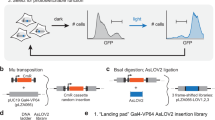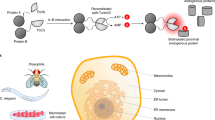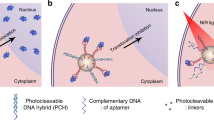Abstract
The incorporation of light-responsive domains into engineered proteins has enabled control of protein localization, interactions and function with light. We integrated optogenetic control into proximity labeling, a cornerstone technique for high-resolution proteomic mapping of organelles and interactomes in living cells. Through structure-guided screening and directed evolution, we installed the light-sensitive LOV domain into the proximity labeling enzyme TurboID to rapidly and reversibly control its labeling activity with low-power blue light. ‘LOV-Turbo’ works in multiple contexts and dramatically reduces background in biotin-rich environments such as neurons. We used LOV-Turbo for pulse-chase labeling to discover proteins that traffic between endoplasmic reticulum, nuclear and mitochondrial compartments under cellular stress. We also showed that instead of external light, LOV-Turbo can be activated by bioluminescence resonance energy transfer from luciferase, enabling interaction-dependent proximity labeling. Overall, LOV-Turbo increases the spatial and temporal precision of proximity labeling, expanding the scope of experimental questions that can be addressed with proximity labeling.
This is a preview of subscription content, access via your institution
Access options
Access Nature and 54 other Nature Portfolio journals
Get Nature+, our best-value online-access subscription
$29.99 / 30 days
cancel any time
Subscribe to this journal
Receive 12 print issues and online access
$259.00 per year
only $21.58 per issue
Buy this article
- Purchase on Springer Link
- Instant access to full article PDF
Prices may be subject to local taxes which are calculated during checkout





Similar content being viewed by others
Data availability
The data associated with this study are available in the article and the Supplementary Information. The original mass spectra, spectral library and the protein sequence database used for searches have been deposited in the public proteomics repository MassIVE (http://massive.ucsd.edu) and are accessible at ftp://massive.ucsd.edu/MSV000090683/. Additional data beyond that provided in the figures and Supplementary Information are available from the corresponding author on request.
References
Bruder, M., Polo, G. & Trivella, D. B. B. Natural allosteric modulators and their biological targets: molecular signatures and mechanisms. Nat. Prod. Rep. 37, 488–514 (2020).
Wu, Y. I. et al. A genetically encoded photoactivatable Rac controls the motility of living cells. Nature 461, 104–108 (2009).
Sanchez, M. I., Nguyen, Q.-A., Wang, W., Soltesz, I. & Ting, A. Y. Transcriptional readout of neuronal activity via an engineered Ca2+-activated protease. Proc. Natl Acad. Sci. USA 117, 33186–33196 (2020).
Kimberly, R. & Ranganathan, R. Hot spots for allosteric regulation on protein surfaces. Cell 147, 1564–1575 (2011).
Branon, T. C. et al. Efficient proximity labeling in living cells and organisms with TurboID. Nat. Biotechnol. 36, 880–887 (2018).
Qin, W., Cho, K. F., Cavanagh, P. E. & Ting, A. Y. Deciphering molecular interactions by proximity labeling. Nat. Methods 18, 133–143 (2021).
Cho, K. F. et al. Proximity labeling in mammalian cells with TurboID and split-TurboID. Nat. Protoc. 15, 3971–3999 (2020).
Wood, Z. A., Weaver, L. H., Brown, P. H., Beckett, D. & Matthews, B. W. Co-repressor induced order and biotin repressor dimerization: a case for divergent followed by convergent evolution. J. Mol. Biol. 357, 509–523 (2006).
Kim, M. W. et al. Time-gated detection of protein-protein interactions with transcriptional readout. eLife 6, e30233 (2017).
Kim, C. K. et al. A molecular calcium integrator reveals a striatal cell type driving aversion. Cell 183, 2003–2019.e2016 (2020).
Lam, S. S. et al. Directed evolution of APEX2 for electron microscopy and proximity labeling. Nat. Methods 12, 51–54 (2015).
Jumper, J. et al. Highly accurate protein structure prediction with AlphaFold. Nature 596, 583–589 (2021).
Guntas, G. et al. Engineering an improved light-induced dimer (iLID) for controlling the localization and activity of signaling proteins. Proc. Natl Acad. Sci. USA 112, 112–117 (2015).
Lee, D. et al. Temporally precise labeling and control of neuromodulatory circuits in the mammalian brain. Nat. Methods 14, 495–503 (2017).
Kawano, F., Aono, Y., Suzuki, H. & Sato, M. Fluorescence imaging-based high-throughput screening of fast- and slow-cycling LOV proteins. PLoS ONE 8, e82693 (2013).
Wang, W. et al. A light- and calcium-gated transcription factor for imaging and manipulating activated neurons. Nat. Biotechnol. 35, 864–871 (2017).
Eitoku, T., Nakasone, Y., Matsuoka, D., Tokutomi, S. & Terazima, M. Conformational dynamics of phototropin 2 LOV2 domain with the linker upon photoexcitation. J. Am. Chem. Soc. 127, 13238–13244 (2005).
Welch, W. J. & Feramisco, J. R. Nuclear and nucleolar localization of the 72,000-dalton heat shock protein in heat-shocked mammalian cells. J. Biol. Chem. 259, 4501–4513 (1984).
Miyamoto, Y. et al. Cellular stresses induce the nuclear accumulation of importin α and cause a conventional nuclear import block. J. Cell Biol. 165, 617–623 (2004).
Kim, C. K., Cho, K. F., Kim, M. W. & Ting, A. Y. Luciferase-LOV BRET enables versatile and specific transcriptional readout of cellular protein-protein interactions. eLife 8, e43826 (2019).
Hall, M. P. et al. Engineered Luciferase reporter from a deep sea shrimp utilizing a novel imidazopyrazinone substrate. Am. Chem. Soc. Chem. Biol. 7, 1848–1857 (2012).
Hedrick, M. N., Lonsdorf, A. S., Hwang, S. T. & Farber, J. M. CCR6 as a possible therapeutic target in psoriasis. Expert Opin. Ther. Targets 14, 911–922 (2010).
Olden, K., Pratt, R. M., Jaworski, C. & Yamada, K. M. Evidence for role of glycoprotein carbohydrates in membrane transport: specific inhibition by tunicamycin. Proc. Natl Acad. Sci. USA 76, 791–795 (1979).
Lytton, J., Westlin, M. & Hanley, M. R. Thapsigargin inhibits the sarcoplasmic or endoplasmic reticulum Ca-ATPase family of calcium pumps. J. Biol. Chem. 266, 17067–17071 (1991).
Haze, K., Yoshida, H., Yanagi, H., Yura, T. & Mori, K. Mammalian transcription factor ATF6 is synthesized as a transmembrane protein and activated by proteolysis in response to endoplasmic reticulum stress. Mol. Biol. Cell 10, 3787–3799 (1999).
Ye, J. et al. ER stress induces cleavage of membrane-bound ATF6 by the same proteases that process SREBPs. Mol. Cell 6, 1355–1364 (2000).
Berthel, E., Foray, N. & Ferlazzo, M. L. The nucleoshuttling of the ATM protein: a unified model to describe the individual response to high- and low-dose of radiation? Cancers 11, 905 (2019).
Zhao, S., Aviles, E. R. Jr & Fujikawa, D. G. Nuclear translocation of mitochondrial cytochrome c, lysosomal cathepsins B and D, and three other death-promoting proteins within the first 60 minutes of generalized seizures. J. Neurosci. Res. 88, 1727–1737 (2010).
Billing, A. M. et al. Proteomic profiling of rapid non-genomic and concomitant genomic effects of acute restraint stress on rat thymocytes. J. Proteom. 75, 2064–2079 (2012).
Hotokezaka, Y., Katayama, I. & Nakamura, T. ATM-associated signalling triggers the unfolded protein response and cell death in response to stress. Commun. Biol. 3, 378 (2020).
Lee, J.-H. & Paull, T. T. Mitochondria at the crossroads of ATM-mediated stress signaling and regulation of reactive oxygen species. Redox Biol. 32, 101511 (2020).
Burman, J. L. et al. Scyl1, mutated in a recessive form of spinocerebellar neurodegeneration, regulates COPI-mediated retrograde traffic. J. Biol. Chem. 283, 22774–22786 (2008).
Tang, Z. et al. Molecular cloning and characterization of a human gene involved in transcriptional regulation of hTERT. Biochem. Biophys. Res. Commun. 324, 1324–1332 (2004).
Ashburner, M. et al. Gene ontology: tool for the unification of biology. The Gene Ontology Consortium. Nat. Genet. 25, 25–29 (2000).
Gene Ontology Consortium. The Gene Ontology resource: enriching a GOld mine. Nucleic Acids Res. 49, D325–d334 (2021).
Hung, V. et al. Proteomic mapping of cytosol-facing outer mitochondrial and ER membranes in living human cells by proximity biotinylation. eLife 6, e24463 (2017).
Amodio, G. et al. Proteomic signatures in thapsigargin-treated hepatoma cells. Chem. Res. Toxicol. 24, 1215–1222 (2011).
Cho, K. F. et al. Split-TurboID enables contact-dependent proximity labeling in cells. Proc. Natl Acad. Sci. USA 117, 12143–12154 (2020).
Hamasaki, M. et al. Autophagosomes form at ER–mitochondria contact sites. Nature 495, 389–393 (2013).
Zabolotny, J. M. et al. PTP1B regulates leptin signal transduction in vivo. Dev. Cell 2, 489–495 (2002).
Galic, S. et al. Coordinated regulation of insulin signaling by the protein tyrosine phosphatases PTP1B and TCPTP. Mol. Cell. Biol. 25, 819–829 (2005).
Kornicka-Garbowska, K., Bourebaba, L., Röcken, M. & Marycz, K. Inhibition of protein tyrosine phosphatase improves mitochondrial bioenergetics and dynamics, reduces oxidative stress, and enhances adipogenic differentiation potential in metabolically impaired progenitor stem cells. Cell Commun. Signal. 19, 106 (2021).
Kennedy, M. J. et al. Rapid blue-light–mediated induction of protein interactions in living cells. Nat. Methods 7, 973–975 (2010).
Kim, W.-Y. et al. ZEITLUPE is a circadian photoreceptor stabilized by GIGANTEA in blue light. Nature 449, 356–360 (2007).
Konermann, S. et al. Optical control of mammalian endogenous transcription and epigenetic states. Nature 500, 472–476 (2013).
Liu, Q. et al. A photoactivatable botulinum neurotoxin for inducible control of neurotransmission. Neuron 101, 863–875.e866 (2019).
Yazawa, M., Sadaghiani, A. M., Hsueh, B. & Dolmetsch, R. E. Induction of protein-protein interactions in live cells using light. Nat. Biotechnol. 27, 941–945 (2009).
Polstein, L. R. & Gersbach, C. A. A light-inducible CRISPR-Cas9 system for control of endogenous gene activation. Nat. Chem. Biol. 11, 198–200 (2015).
Liu, Y. et al. Spatiotemporally resolved subcellular phosphoproteomics. Proc. Natl Acad. Sci. USA 118, e2025299118 (2021).
Hananya, N., Ye, X., Koren, S. & Muir, T. W. A genetically encoded photoproximity labeling approach for mapping protein territories. Proc. Natl Acad. Sci. USA 120, e2219339120 (2023).
Zhai, Y. et al. Spatiotemporal-resolved protein networks profiling with photoactivation dependent proximity labeling. Nat. Commun. 13, 4906 (2022).
Chao, G. et al. Isolating and engineering human antibodies using yeast surface display. Nat. Protoc. 1, 755–768 (2006).
Colby, D. W. et al. Engineering antibody affinity by yeast surface display. Methods Enzymol. 388, 348–358 (2004).
Gagnon, K. T., Li, L., Janowski, B. A. & Corey, D. R. Analysis of nuclear RNA interference in human cells by subcellular fractionation and Argonaute loading. Nat. Protoc. 9, 2045–2060 (2014).
Senichkin, V. V., Prokhorova, E. A., Zhivotovsky, B. & Kopeina, G. S. Simple and efficient protocol for subcellular fractionation of normal and apoptotic cells. Cells 10, 852 (2021).
Acknowledgements
Rat cortical neurons were a kind gift from M. Lin (Stanford University). We thank J. Reinstein (Max Planck Institute) for helpful feedback. This work was supported by the NIH (grant nos. R01-DK121409 and RC2DK129964 to A.Y.T., R01-OD026223 to A.Y.T. and S.A.C. and T32GM007276 to J.S.C.), the Stanford Wu Tsai Neurosciences Institute (A.Y.T.), the National Science Foundation (NeuroNex grant no. 2014862 to A.Y.T. and GRFP DGE-1656518 to J.S.C.), the National Research Foundation of Korea grant no. NRF-2019R1A6A3A03033677 (S.-Y.L.), the Stanford Gerald J. Lieberman Fellowship (J.S.C.) and the Burroughs Wellcome Fund grant no. CASI 1019469 (C.K.K.). A.Y.T. is a Chan Zuckerberg Biohub – San Francisco Investigator.
Author information
Authors and Affiliations
Contributions
S.-Y.L. and A.Y.T. conceived this project. S.-Y.L., J.S.C. and A.Y.T. designed experiments and analyzed all the data except those noted. S.-Y.L. and J.S.C. performed all experiments, unless otherwise noted. N.D.U., C.X. and S.A.C. performed post-streptavidin-enrichment sample processing, mass spectrometry, and initial data analysis. B.Z. and S.-Y.L. performed the mouse brain experiments. C.K.K., K.F.C. and S.-Y.L. performed cultured rat cortical neuron experiments. H.R. and S.-Y.L. performed BRET experiments. S.-Y.L., J.S.C. and A.Y.T. wrote the paper with input from all authors.
Corresponding author
Ethics declarations
Competing interests
S.-Y.L., J.S.C. and A.Y.T. have filed a patent application covering some aspects of this work (US Provisional Patent Application No. 63/488,940; CZ SF ref. CZB-273S-P1; Stanford ref. S22-487; KT ref. 110221-1361830-009500PR). The remaining authors declare no competing interests.
Peer review
Peer review information
Nature Methods thanks Angelos Constantinou, Tatsuya Sawasaki and the other, anonymous, reviewer(s) for their contribution to the peer review of this work. Primary Handling Editor: Rita Strack, in collaboration with the Nature Methods team.
Additional information
Publisher’s note Springer Nature remains neutral with regard to jurisdictional claims in published maps and institutional affiliations.
Supplementary information
Supplementary Information
Supplementary Figs. 1–8, Table 1, Legends of Tables 2–4, Note 1, Methods, Antibodies list, Genetic constructs list and References.
Supplementary Table 2–4
Table 2: Proteomic data for ERM to nucleus pulse-chase experiment. Table 3: Proteomic data for ERM to mitochondria pulse-chase experiment. Table 4: Proteomic data at peptide level for ERM to nucleus pulse-chase experiment.
Rights and permissions
Springer Nature or its licensor (e.g. a society or other partner) holds exclusive rights to this article under a publishing agreement with the author(s) or other rightsholder(s); author self-archiving of the accepted manuscript version of this article is solely governed by the terms of such publishing agreement and applicable law.
About this article
Cite this article
Lee, SY., Cheah, J.S., Zhao, B. et al. Engineered allostery in light-regulated LOV-Turbo enables precise spatiotemporal control of proximity labeling in living cells. Nat Methods 20, 908–917 (2023). https://doi.org/10.1038/s41592-023-01880-5
Received:
Accepted:
Published:
Issue Date:
DOI: https://doi.org/10.1038/s41592-023-01880-5
This article is cited by
-
Programmable RNA base editing with photoactivatable CRISPR-Cas13
Nature Communications (2024)
-
Nuclear pores beyond macromolecule channels
Nature Plants (2024)
-
Enzyme-mediated proximity labeling for mapping molecular interactions
Science China Life Sciences (2023)



